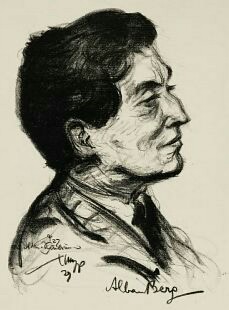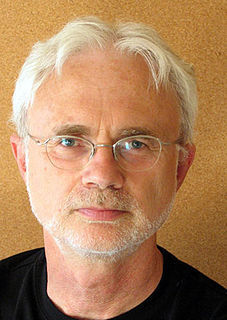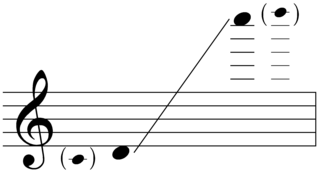
Alban Berg's Violin Concerto was written in 1935. It is probably Berg's best-known and most frequently performed instrumental piece, in which the composer sought to reconcile diatonicism and dodecaphony. Berg composed it on a commission from Louis Krasner, and it became the last work that he completed. Krasner performed the solo part in the premiere at the Palau de la Música Catalana, Barcelona on 19 April 1936, after the composer's death.
Lincoln Portrait is a classical orchestral work written by the American composer Aaron Copland. The work involves a full orchestra, with particular emphasis on the brass section at climactic moments. The work is narrated with the reading of excerpts of Abraham Lincoln's great documents, including the Gettysburg Address. An orchestra usually invites a prominent person to be the narrator.
Richard Danielpour is an American composer.

Connotations is a classical music composition for symphony orchestra written by American composer Aaron Copland. Commissioned by Leonard Bernstein in 1962 to commemorate the opening of Philharmonic Hall in New York City, United States, this piece marks a departure from Copland's populist period, which began with El Salón México in 1936 and includes the works he is most famous for such as Appalachian Spring, Lincoln Portrait and Rodeo. It represents a return to a more dissonant style of composition in which Copland wrote from the end of his studies with French pedagogue Nadia Boulanger and return from Europe in 1924 until the Great Depression. It was also Copland's first dodecaphonic work for orchestra, a style he had disparaged until he heard the music of French composer Pierre Boulez and adapted the method for himself in his Piano Quartet of 1950. While the composer had produced other orchestral works contemporary to Connotations, it was his first purely symphonic work since his Third Symphony, written in 1947.

The E-flat clarinet is a member of the clarinet family. It is typically considered the sopranino or piccolo member of the clarinet family. Smaller in size and higher in pitch than the more common B♭ clarinet, it is a transposing instrument in E♭, sounding a minor third higher than written. In Italian it is sometimes referred to as a terzino and is generally listed in B♭-based scores as terzino in Mi♭,
Aaron Copland's Clarinet Concerto was written between 1947 and 1949, although a first version was available in 1948. The concerto was later choreographed by Jerome Robbins for the ballet Pied Piper (1951).
Chamber Symphony No. 2, Op. 38, by Arnold Schoenberg was begun in 1906 and completed in 1939. The work is scored for 2 flutes, 2 oboes, 2 clarinets, 2 bassoons, 2 horns, 2 trumpets and strings, and is divided into two movements, the first marked Adagio and the second marked Con Fuoco-Lento. The work's belated completion was prompted by the conductor Fritz Stiedry, who asked Schoenberg for an orchestral piece for his New Friends of Music Orchestra in New York. The work was first performed there on December 14, 1940, under Stiedry's direction.
Fenwick Smith was an American flutist. He studied under Joseph Mariano at the Eastman School of Music, graduating from there in 1972. Shortly thereafter he became a member of the New England Woodwind Quintet and began a thirteen-year membership with Boston Musica Viva. He became the assistant principal flutist of the Boston Symphony Orchestra in 1978, serving in that position until September 2006. During this time he was also principal flutist of the Boston Pops Orchestra. Smith was also a member of the Boston Chamber Music Society since 1984, and since 1983 gave annual recitals at Jordan Hall.
The Chamber Symphony No. 1 in E major, Op. 9 is a composition by Austrian composer Arnold Schoenberg.

Chamber Symphony is a 1992 composition for a 15-member chamber orchestra by American composer John Adams, inspired by Arnold Schoenberg's Chamber Symphony No. 1, Op. 9. It is a three-movement work that takes about 23 minutes to perform.

Spirit of the American Range is a classical music album by the Oregon Symphony under the artistic direction of Carlos Kalmar, released by Dutch record label Pentatone on February 10, 2015. The album was recorded at the Arlene Schnitzer Concert Hall in Portland, Oregon in April 2013 and January 2014. It contains works by three American 20th-century composers: Walter Piston's ballet suite from The Incredible Flutist, George Antheil's "A Jazz Symphony", and Aaron Copland's Symphony No. 3. The recording was the third by the orchestra under Kalmar's leadership, following the highly successful Music for a Time of War (2011) and This England (2012). Spirit of the American Range received a Grammy Award nomination for Best Orchestral Performance, and its producer, Blanton Alspaugh, was nominated for Producer of the Year, Classical.
blue cathedral is an orchestral composition by the American composer Jennifer Higdon. The work was commissioned by the Curtis Institute of Music in 1999 to commemorate the conservatory's 75th anniversary. It was first performed in 2000 by the Curtis Institute of Music Symphony Orchestra. The piece is dedicated to the memory of Higdon's brother and is one of the composer's most performed works.
Purple Rhapsody is a viola concerto by the American composer Joan Tower. The work was jointly commissioned by the Omaha Symphony Orchestra with the Buffalo Philharmonic Orchestra, the Virginia Symphony Orchestra, the Kansas City Symphony, the ProMusica Chamber Orchestra, Peninsula Music Festival Orchestra, and the Chautauqua Symphony Orchestra with a grant from the Serge Koussevitzky Music Foundation in the Library of Congress. It was first performed on November 4, 2005, by the Omaha Symphony Orchestra and the violist Paul Neubauer, to whom the piece is dedicated.
Geoffrey Gordon is an American composer of classical music.
Finding Rothko is a composition for chamber orchestra by the American composer Adam Schoenberg. The work was commissioned by the Germantown, Tennessee-based IRIS Orchestra under the conductor Michael Stern. It was first performed by the IRIS Orchestra under Stern on January 13, 2007.
Picture Studies is an orchestral suite by the American composer Adam Schoenberg. The work was commissioned by the Kansas City Symphony and the Nelson-Atkins Museum of Art. It was first performed by the Kansas City Symphony conducted by Michael Stern at the Kauffman Center for the Performing Arts in Kansas City on February 1, 2013.
Music for Cello and Orchestra is a composition for cello and orchestra by the American composer Leon Kirchner. The work was commissioned by the Philadelphia Orchestra for the cellist Yo-Yo Ma. The work was first performed by Yo-Yo Ma and the Philadelphia Orchestra under the conductor David Zinman in Philadelphia on October 16, 1992. The piece was a finalist for the 1993 Pulitzer Prize for Music.
The Concerto for Piano and Orchestra is a musical composition by the American composer Aaron Copland. The work was commissioned by the conductor Serge Koussevitzky who was then music director of the Boston Symphony Orchestra. It was first performed on January 28, 1927, by the Boston Symphony Orchestra conducted by Koussevitzky with the composer himself as the soloist. The piece is dedicated to Copland's patron Alma Morgenthau Wertheim.











